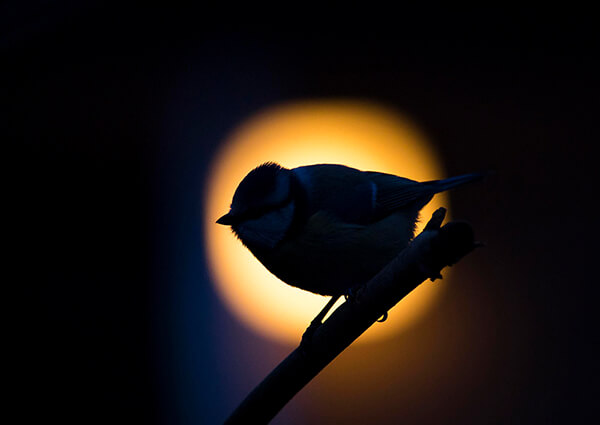
Bird photography tips for beginners: basic settings
08 June 2019, by Oana Badiu
Wildlife photography and especially bird photography require a lot of skill and patience. Here are a few tips for beginners to improve your photography skills!
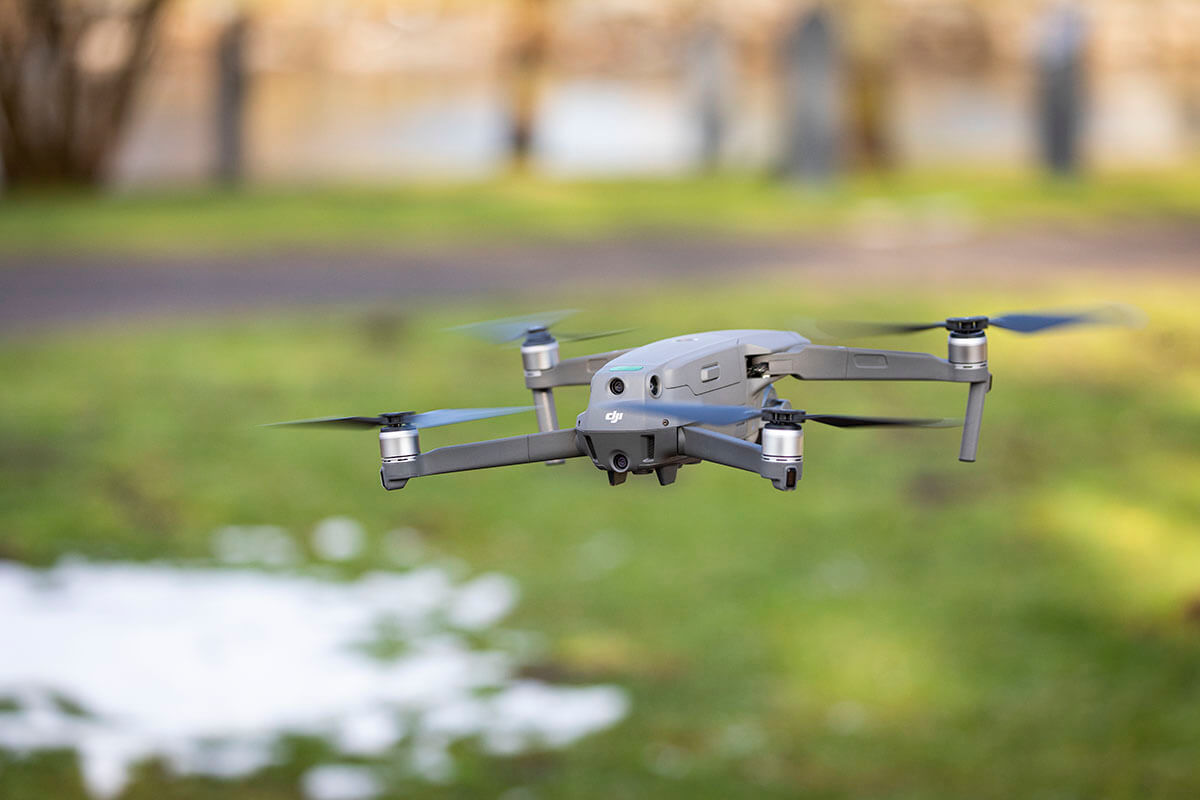
06 July 2019, by Oana Badiu
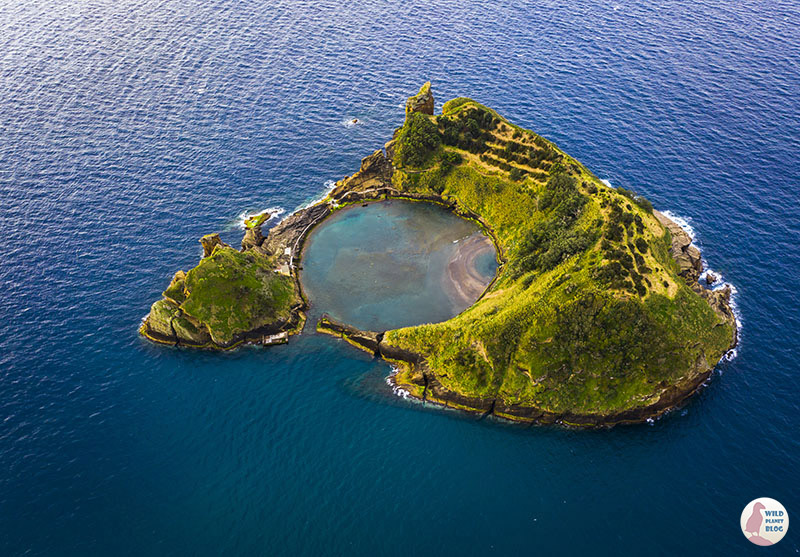
I really loved the idea of having a drone, especially after seeing from the videos how easy it is to fly. Before buying my DJI Mavic Pro 2, flying the drone was my main concern. I was afraid that I am going to crash it and I saw quite a few videos where drones get crashed. After my main concern disappeared I decided to just go for it! I ordered the DJI Mavic Pro 2 and the Fly More Kit and I was ready to roll!
Let's talk a bit about the flying experience with DJI Mavic Pro 2. For a beginner flying the drone was super easy, seems that the drone is very stable and looks like I have nothing to worry about. I don't dare to land it in my hand yet, so I always try to find a nice surface for launch and for landing. What I find a bit annoying is when I place my phone in the remote control, some it takes me quite some time to plug it in, since I have a big phone, but eventually it works.
This below is my first image ever taken with the DJI Mavic Pro 2. It was winter and my hands were freezing, but I was happy to fly the drone!
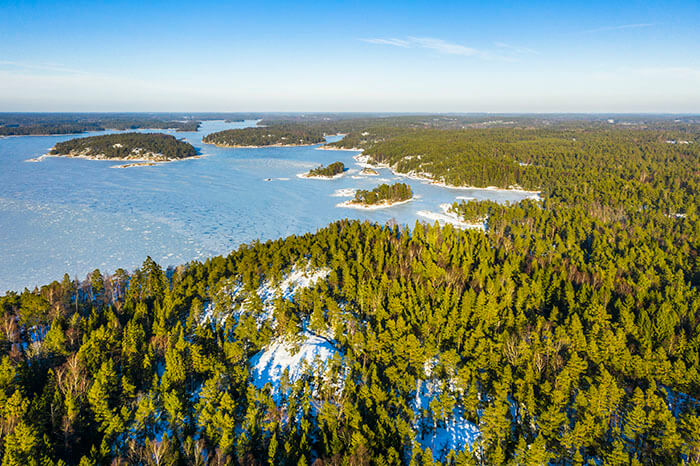
For a while I didn't dare to fly it when it was really windy, but during my trip to Azores I was a little desperate. Until the last evening I tried to fly it only if the wind was mild and if I got warnings from the drone I immediately landed the drone. My plan was to fly the drone at sunrise, when the wind has lower speed, however 4 mornings out of 7 it was super cloudy in the mountains and I couldn't see anything. During my last day I realised that I don't have enough footage and it was super windy off the coast of Mosteiros, so I decided to take my chances and try it out. To my surprise the drone made it to the small rocky islands from the picture below and back, without a problem. This was not an ideal situation and maybe I could have lost my drone, but I think DJI Mavic Pro 2 can handle normal coast winds pretty well.
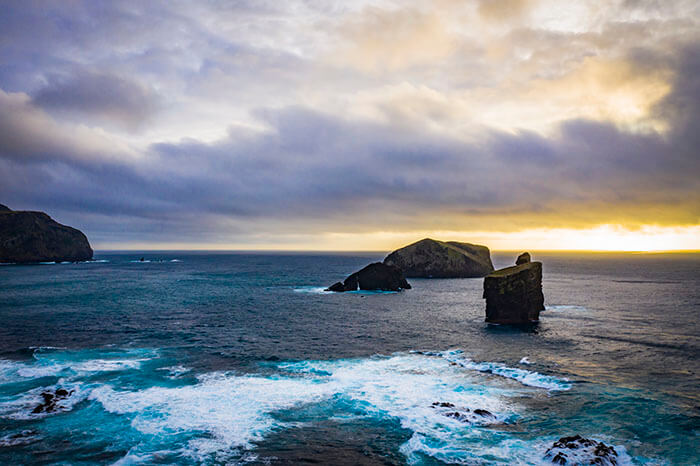
I am used to taking pictures using Canon 5D Mark IV, which has amazing quality, so initially I was not so impressed with the HASSELBLAD L1D-20C camera. It has poor DOF, so the "tricks" I used to do with my normal camera don't work very well with the DJI Mavic Pro 2 pictures. The camera doesn't handle that well high ISO, so I would recommend to not go over 500. The image or the video gets quite grainy and if you try to reduce the noise afterwards, the picture/video becomes very unclear. I always shoot in RAW format, so I haven't even tried the auto mode. DJI MAVIC PRO 2 produces a .DNG RAW file, which I can edit using Adobe Photoshop. I guess the big win with this drone is not the amazing picture quality, but the fact that you can take pictures of places where your normal camera can never go to (unless you rent a helicopter). So thinking about how small and compact DJI MAVIC PRO 2 is and that I can fit it in my luggage without problems, I actually believe that the HASSELBLAD is pretty good for its compact size.
Here is one of my favorite pictures that I took with DJI Mavic Pro 2. I couldn't have taken this picture without my drone! The light was pretty good, so I think the quality is pretty good as well.
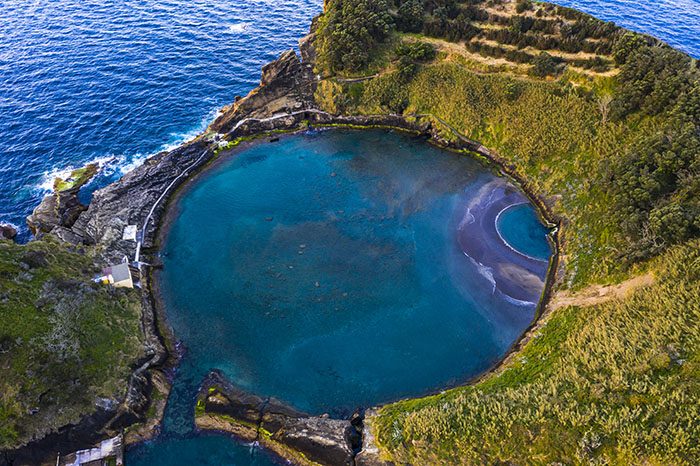
Open the original, processed image of Islet of Vila Franca do Campo, Azores
Picture is taken at ISO 100, 1/20 sec, 10.26 mm (this camera doesn't have zoom), f/7.1 and the original file is 5464x3640. One very cool feature that its predecessor, DJI Mavic Pro, didn't have is that the camera's aperture is adjustable, which is an awesome feature when taking pictures!
Overall I think this drone is a good value for money. The videos it produces are not of the same quality as a big, professional drone, but I would say it's pretty impressive! Again, you should keep the ISO levels as low as possible (don't exceed 500). I tried to take a video quite early in the morning, but it turns out the video is really really noisy and unusable. I have noticed that the best time to take a video would be early morning, maybe one hour or 2 after the sun has risen. During this time it's bright enough to keep your settings optimal for the video. I have researched quite a lot about what kind of settings you need to get a good footage. DJI Mavic Pro 2 comes with the awesome feature of being able to adjust the aperture, but the recommended setting for a clear video is not to lower the aperture beyond 5.6. Also you should film at 1/30 or 1/60 fps for a nice cinematic video. While I know all of this, I still find it quite difficult to keep those settings, because it's usually quite bright and often I try to adjust to the light conditions. Sometimes I forget about these settings and it seems that I pay the price afterwards.
To fix this issue I bought PolarPro Filter 6PK (ND4, ND8, ND16, ND4/PL, ND8/PL, ND16/PL DJI Mavic 2 Filters). I tried them a few times, but I found that it takes a bit of effort to change them according to the light. I don't have that much experience yet, so I need to fly the drone high and check the light and then fly it back down and adjust the filter if I got it wrong. Maybe this is one reason why I prefer to fly my drone early in the morning because at that time I don't need to use any filters. One other complaint would be that the filters come in a box that has magnets for each of the filters, which mess up the drone's compass. One time I forgot that I had the box in my pocket and after take off, my drone went all crazy and didn't really follow any of the directions from the remote control. I barely managed to land it and afterwards I realised why it went all crazy.
UPDATE 18.01.2020
In the meantime I learned the importance of the filters and now I actually don't fly my drone anymore without them. It's really important for the video quality to try your best to have 1/30 sec shutter speed or max 1/60 because your video is shot at 1/30 fps. As a general rule use ND16 on a very bright and sunny day without clouds, ND8 on a day with clouds and ND4 very early morning or late evening when the sun is still shining. Check my latest video "Epic Lofoten Islands, Norway Drone Video, 4K, DJI Mavic Pro 2
I tried also the automatic time-lapse feature where the Mavic Pro 2 flies from point A to point B, but the result was quite terrible. It was a bit windy (but not too much) and it seems that the drone moved too much between the shots. Maybe I will try it again when there is no wind at all, but I was very disappointed by that feature. I was so pissed off that I even deleted the footage right away when I got home.
During my first day of flying I took quite many videos (I filmed as long as my 3 batteries lasted, so about one hour). Then I went home to check the footage and I was happy to start creating a video. I purchased Adobe Premiere Pro and I started to create my video. After 30 seconds of footage my computer froze and I couldn't play anything in Premiere. I followed all the instructions with creating caches in Premiere and setting everything right, but it was still too much for my 5 years old computer to handle. I had better settings than what Adobe is recommending to have for Premiere Pro to work. Until that day my computer was powerful enough to handle everything I had to do (Photoshop included), but this was too much for it. After researching a bit I quickly found out that video processing is serious business and it takes huge amount of processing power! Somehow I didn't even think about this issue before and I didn't see anything written about it in any articles about drones. Here I was, having a drone and footage, but couldn't use it for anything. So I quickly realised that the investment I had to make to get started was a lot more than the price of the drone.
This was just one of the surprises that I encountered on my journey to create my first video. Here are a few things that I wish I had known before I purchased my DJI Mavic Pro 2.
Drones are getting more and more popular and even though it feels like you're flying a toy, in fact, you are NOT! This is an aircraft and it has the potential of doing a lot of damage! London airport was closed down because of some bad people that flew their drones close to the airport intentionally! You might feel like your drone is very safe if you are flying it the correct way and in the right conditions. Usually that is the case, BUT there are videos out there with drones just dropping out of the sky or being attacked by birds etc.. If those drones would fall in someone's head, that someone would get serious injuries, if not even be killed by your drone! Nowadays ANYONE can buy a drone and ANYONE can do damage, so a lot of regulations have been put in place to restrict this from happening, which is something that I understand completely and until recently I thought that it's mainly like "don't fly close to airports, don't fly above crowds, keep your drone close by etc". Those seemed very reasonable to me and I feel like I am a responsible person and I don't need any laws to tell me otherwise, but probably a lot of people are not. Also I am usually flying my drone at sunrise because I don't really want any people in my footage and I love the light during that time. Recently I went on a one week trip to Croatia and before leaving I researched a little bit about the drone laws in Croatia. Well, I ended up buying a GoPro Hero 7 just before leaving because after reading everything I decided to not take my drone. First of all, I needed to request permission from the Croatian authorities about one month before my visit, otherwise I am not allowed to take any footage. Then, a lot of places where I wanted to use my drone were "drone free" areas. Seems that the Croatian authorities are taking this very seriously and there were people fined and their videos were taken down from YouTube by the Croatian authorities. Next month I will go to Norway and it seems that even there I would need to submit a form to the Norwegian authorities if I would ever like to monetize my videos.
In conclusion, check way before your trip about the laws in the countries where you are planning to fly your drone, in order to be able to get all the approvals required before your visit.
I already shared part of my story and the fact that I had a drone, but I couldn't really do much with it, except for taking pictures. Since I was serious about my hobby and I was dreaming of someday maybe making some money out of this, I invested a LOT of money and bought the most expensive and powerful MacBook Pro I could find at the time. It has a 2.3 Ghz 8-core Intel I9 processor, 32 Gt of memory, 1Tb PCIe hard drive, Radeon Vega 20 graphics. The other option would have been a 3kg Windows machine, almost as expensive as this one. Maybe I went a little crazy there, but I value my time very very much! I am very happy with my purchase, but I am still paying for it and I wasn't planning for this kind of investment when I first bought the Mavic Pro 2. If I knew this was the case I would have probably waited a bit longer to get the money I needed. The Macbook Pro that I bought does the job well, but I am transitioning from Windows to Mac, so it's a slow and painful process at the moment. I was able to complete my first video from Azores using it! You can check the video on my youtube page.
I was thinking that 2 hours footage would be more than enough for my Azores 4 min video, but I was wrong. If you want to make your video beautiful, you cannot use more than around 15-20s of the same frame, otherwise people lose interest. You also have to switch the frames in the rhythm of the music and the footage itself should follow the rhythm of the music as well, so instead of 1 min of great footage, you might end up with just 10s because you had increase the speed of the footage to match with your music. So in conclusion, take as much footage from as many places as you can while you are on the field. It will come in handy when editing a video. For my first video I had to cut my song short simply because I was repeating myself. I am still repeating myself and I would have liked to have more places in the video, but I had to work with what I had. I also incorporated a couple of time-lapses taken with my camera. You can check the video on my youtube page.
Both YouTube and Facebook have some preliminary requirements in order to let you add advertisements in your videos.
Facebook requirements for ad breaks:
- your page needs to have at least 10 000 followers
- in the last 60 days you need to have 30 000 1-minutes views for videos that are AT LEAST 3 minutes long
- your page needs to meet the "Partner Monetization Policies" standard
- facebook ads need to be supported in your country
These are some serious requirements and I am missing 3 of them. It takes huge amount of time and money to meet these requirements and Finland, where I live, is not even supported.
Youtube requirements for monetization:
- your profile needs to have at least 1 000 subscribers
- have at least 4 000 hours of watch time in the past 12 months
- adhere to the partner policies
Youtube has nicer requirements, however there are lots of people out there, so even getting these requirements is very difficult.
Also, if you want to monetize your videos you need to buy your music and I found out that the cool music it's not really available to buy for a single person. There is premiumbeat.com, owned by Shutterstock that might have some nice music, but one song costs 49 €. Not cheap and there is no guarantee you'll get your money back.
There are lots of things that might have thrown me off a little from my first drone purchase and things are not as easy as I thought they would be. DJI Mavic Pro 2 is an excellent drone for beginners, easy to fly, has a lot of sensors that prevent you from crashing it easily, it's light and, overall, a great piece of engineering! If you are determined, you'll get pass the "obstacles" and enjoy your drone to the fullest!
Here is other picture that would have been impossible to get without my DJI Mavic Pro 2!
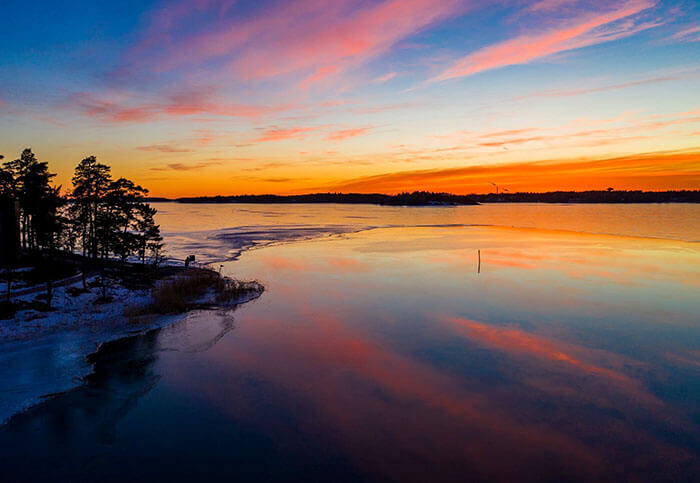
I hope this doesn't throw you off, but I feel you must have all the facts straight before making this decision. After I completed my first drone video I was very happy and I don't know yet if all the money and effort was worth it, but at least I know I can look at that video I made and remind myself of the beautiful places I have visited for years to come.
Check out my first video on youtube, "São Miguel Island, Azores 4K, DJI Mavic Pro2 and Canon 5D Mark IV". More to come!